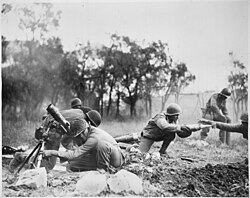
Back الخط القوطي Arabic Готска линия Bulgarian Gótská linie Czech Gotenstellung German Gota Linio Esperanto Línea Gótica Spanish Gootti-linja Finnish Ligne gothique French הקו הגותי HE Garis Gothic ID
| Gothic Line Offensive | |||||||
|---|---|---|---|---|---|---|---|
| Part of the Italian Campaign of World War II | |||||||
 German defensive positions in Northern Italy, 1944 | |||||||
| |||||||
| Belligerents | |||||||
|
|
| ||||||
| Commanders and leaders | |||||||
|
|
| ||||||
| Strength | |||||||
|
|
| ||||||
| Casualties and losses | |||||||
| Unknown | Unknown | ||||||

The Gothic Line (German: Gotenstellung; Italian: Linea Gotica) was a German and Italian defensive line of the Italian Campaign of World War II. It formed Field Marshal Albert Kesselring's last major line of defence along the summits of the northern part of the Apennine Mountains during the fighting retreat of the Axis forces in Italy against the Allied Armies in Italy, commanded by General Sir Harold Alexander.
Adolf Hitler had concerns about the state of preparation of the Gothic Line: he feared the Allies would use amphibious landings to outflank its defences. To downgrade its importance in the eyes of both friend and foe, he ordered the name, with its historic connotations, changed, reasoning that if the Allies managed to break through they would not be able to use the more impressive name to magnify their victory claims. In response to this order, Kesselring renamed it the "Green Line" (Grüne Linie) in June 1944.
Using more than 15,000 slave labourers, the Germans created more than 2,000 well-fortified machine gun nests, casemates, bunkers, observation posts and artillery fighting positions to repel any attempt to breach the Gothic Line.[1] Initially, this line was breached during Operation Olive (also sometimes known as the Battle of Rimini), but Kesselring's forces were consistently able to retire in good order. This continued to be the case up to March 1945, with the Gothic Line being breached but with no decisive breakthrough; this would not take place until April 1945 during the final Allied offensive of the Italian Campaign.[2]
Operation Olive has been described as the biggest battle of materials ever fought in Italy. Over 1,200,000 men participated in the battle. The battle took the form of a pincer manoeuvre, carried out by the British Eighth Army and the U.S. Fifth Army against the German 10th Army (10. Armee) and German 14th Army (14. Armee). Rimini, a city which had been hit by previous air raids, had 1,470,000 rounds fired against it by allied land forces. According to Lieutenant-General Oliver Leese, commander of the British Eighth Army: "The battle of Rimini was one of the hardest battles of Eighth Army. The fighting was comparable to El Alamein, Mareth, and the Gustav Line (Monte-Cassino)."